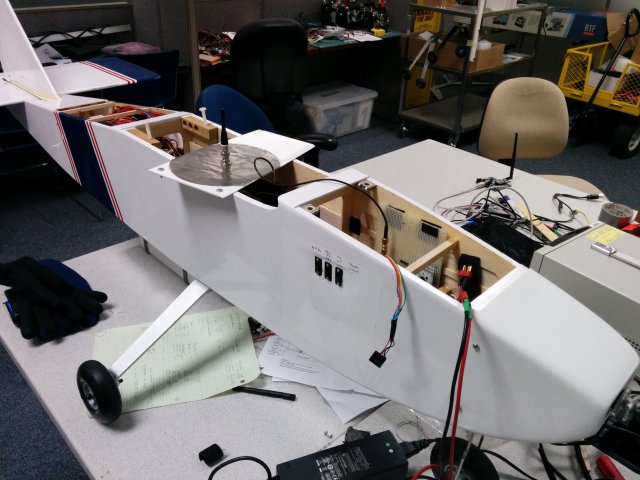 Cadets in the US Air Force Academy’s Systems Engineering 460 course are engineering a remotely piloted aircraft programme and platform to monitor ponderosa pine trees for beetle infestations. They’re set to select a sensor for their RPA that can scan trees in near-infrared and visible light wavelengths to spot ips beetle infestations.
Cadets in the US Air Force Academy’s Systems Engineering 460 course are engineering a remotely piloted aircraft programme and platform to monitor ponderosa pine trees for beetle infestations. They’re set to select a sensor for their RPA that can scan trees in near-infrared and visible light wavelengths to spot ips beetle infestations.
Rocky Mountain bark beetles have killed trees across more than 4 million acres in the Western United States, according to the U.S. Forest service. But the lesser-known ips beetle, also called the engraver beetle, is an order of magnitude more difficult to manage, said Colonel Steven Hasstedt, the Academy’s assistant professor of biology.
“With the pine beetles, you have one generation or maybe two generations per year,” said Hasstedt, who holds a doctorate in ecology with an emphasis on forestry. “Ips are five-plus generations per year, so they’re much more prolific. They have the potential to infest a lot more trees.”
Once the Academy finds an affected tree, the 10th Civil Engineer Squadron cut the tree down, chip the branches, strip the bark from the trunk and leave it to dry out, killing the larvae. The 10th CES normally does this within a week of spotting the tree, but spotting the trees is a laborious process, said Steve Wallace, a natural resources planner with the squadron.
“I do a lot of hiking looking for infestations, but I can’t see down into every drainage,” Wallace said. “We’ll never catch all of the trees, because the Academy’s not a closed system … but what we’re doing is trying to catch as many as we can so we don’t lose a whole bunch of trees.”
The sensor that cadets select must be able to spot subtle colour changes, ideally as the pines’ dark green needles fade to light green, before they turn yellow or brown.
“At that point, the beetles are long-gone,” Hasstedt said. “They’ve spread. So the key is trying to catch them when the needles are kind of lime-green, as they’re turning.” At that point, the beetles infesting a branch are still in the larval stage.
In addition, cadets will look for subtle differences in the pine needles’ temperature and moisture content using near-infrared sensors, Hasstedt said. The RPA crew would note affected trees’ coordinates and pass those along to natural resources personnel, who could confirm whether the trees are infested.
“They’ll start seeing what sensors are available and can be used within the unmanned aerial system restrictions to perform that mission,” Hasstedt said. “A multi-spectral sensor is what they’re trying to use.”
Within the next couple of weeks, the cadets will try to mount the sensor they select onto their RPA platform, Hasstedt said. Sophomores in the Academy’s RPA program are checked out on platform and are almost ready to start flight operations.
“There are a lot of moving pieces from the technical side,” he said. “We’ll see how well that works. Are they getting the appropriate resolution and swath that they need?”
The timing will roughly correspond with the beginning of beetle season.
“As we’re coming out of winter, everything’s still dormant,” Hasstedt said. “But as it warms up, they’ll start responding.”
Most of the trees in Jacks Valley, where the cadets will conduct their RPA flights, were identified and cleared last year, the colonel said.
“I just went out with Steve last Thursday and found a couple of trees, but they’ll start spreading, so that’ll be a good test area for them,” Hasstedt said. “The cadets have baselined their sensors to different sample trees all over the base.”
From a program management perspective, the instructors take a mostly hands-off perspective, Hasstedt said.
“We’re really trying to let them plug in with nudges and figure this out on their own — not just letting them flail, but giving them a little course correction every once in a while,” he said. “It’s a learning process for cadets.” That approach also allows cadets to brainstorm in directions their instructors might not have thought of.
The project includes cadets from several majors, including geospatial science, law and management. Faculty involved in the project includes representatives from half of the Academy’s 26 academic departments.
The cadets’ project, when complete, wouldn’t save the Air Force Academy a large amount of money, but the value would scale upward with the acreage of forest an agency manages.
“That’s where the Forest Service interest is,” Hasstedt said.
“It wouldn’t eliminate the need for field surveys on our part, but it would add better perspective,” Wallace said. “This would help us to key in on some of those areas that might not be as apparent to me with a set of binoculars.”
